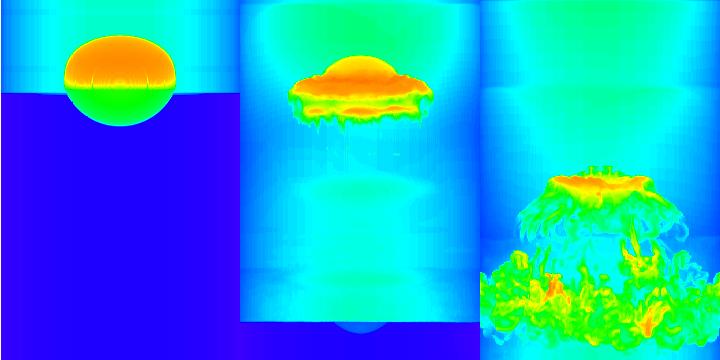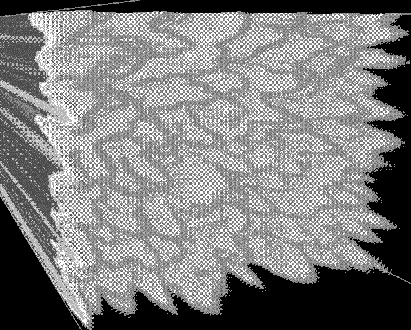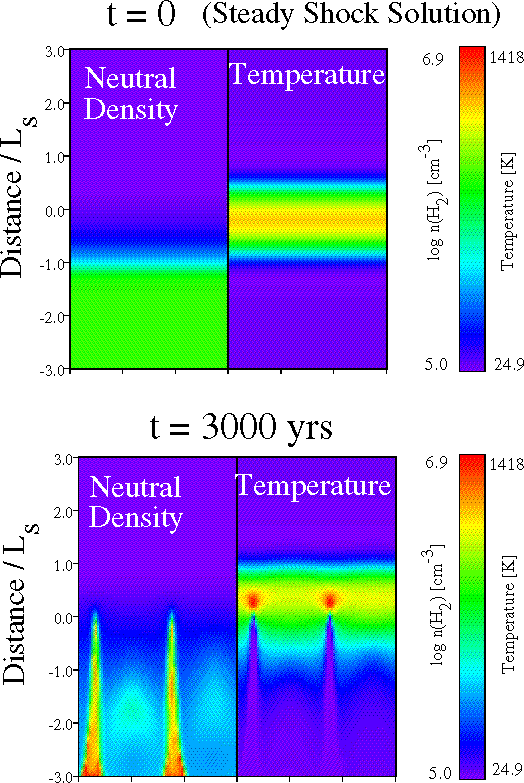Shocks are produced in the interstellar medium (ISM) by a wide variety of sources: supernovae, stellar winds, and protostellar mass outflows. Understanding the time-dependent evolution of interstellar shocks, and their effect on the various phases of the ISM, requires numerical simulation.
The work shown here has been done in collaboration with Mark Edelman (CIM),
David Neufeld (JHU), and Mike Norman (UIUC).
![]()
Strong shocks can either disrupt dense interstellar clouds, mixing cold dense gas into the warm phase, or they may compress such clouds and trigger star formation. Numerical simulations of an idealized problem: the interaction of a strong, planar shock front with a spherical clump of denser gas, can help determine which is more likely. In fact, this problem has a long history of study both by laboratory experiments and computational methods: it has even been used as a test problem for comparison of numerical algorithms.
The image below shows the column density from the first 3D simulation of the shock-cloud interaction at three different times in the evolution. The Mach number of the shock is 10, and the cloud is initially 10 times denser than its surroundings. The evolution is computed using the PPM code CMHOG on a grid of 128x128x256 zones. The shock propagates from top to bottom, and time increases from left to right.

At early times, the cloud is simply compressed, but hydrodynamical instabilities driven by the shear at the cloud surface as the postshock gas flows over the compressed cloud eventually disrupts it into a network of filaments and clumps. Evidently the mixing rate of the cloud into the warm phase is large in this case, and triggered star formation is unlikely. The latter may be possible with weaker shocks and larger clouds.
Numerical simulations have also been used to study the evolution of different shapes of 3D clouds, and the effect of magnetic fields in suppressing mixing. More detail can be found in the following papers:
``The Three-Dimensional Interaction of a Supernova Remnant with an Interstellar Cloud", by J.M. Stone & M.L. Norman The Astrophysical Journal Letters, 390, L17 (1992).Slow magnetosonic shocks are unstable to small perturbations in their shape or velocity. Numerical MHD simulations can be used to follow the growth of this "corrugation" instability through to saturation in the nonlinear regime. The image below shows a volumetric rendering of the density in a 3D simulation of an unstable shock with a sonic Mach number of 10 and an Alfvenic Mach number of 0.5. The shock is propagating out of the page (and parallel to the magnetic field lines), so that the image shows the surface of the postshock compressed density.

The shock front has become distorted into "fingers", with the postshock density highest between the fingers as the preshock flow is channeled between the peaks. Slow MHD shocks are expected to occur at the base of magnetically-channeled accretion columns on strongly magnetized neutron stars and white dwarfs. Thus, the corrugation instability may play a role in producing variability in the emission from the postshock gas.
More detail can be found in the following paper:
``The Corrugation Instability in Slow MHD Shocks", by J.M. Stone & M. Edelman, The Astrophysical Journal, 454, 182 (1995).In the densest regions of the ISM, the ionization fraction of the gas becomes so low that the ions and neutrals are only weakly coupled. Weak MHD shocks in this case have a more complex structure than in a fully ionized gas. In particular, Mark Wardle has shown that "C-type" shocks (in which all flow properties vary continuously from upstream to downstream states) are unstable to perturbations in the shape of the shock front. By extending the ZEUS code to treat a weakly ionized, two-fluid media, the growth and saturation of the Wardle instability could be followed in a variety of circumstances.

The image on the left shows the density and temperature in the initial state, and after saturation of the Wardle instability in an initially planar C-type shock propagating perpendicular to the magnetic field lines. Click on the image to download a full-sized version.
The instability generates dense sheets of neutral gas in the
postshock flow, with hot gas located at the tip of each sheet.
Although the variations in the temperature caused by the
instability are significant, calculations show the observed spectrum of
the shock is not greatly affected.
More detail can be found in the following papers:
``The Wardle Instability in Interstellar Shocks: I. Nonlinear Dynamical Evolution", by J.M. Stone, The Astrophysical Journal , 487, 271 (1997).